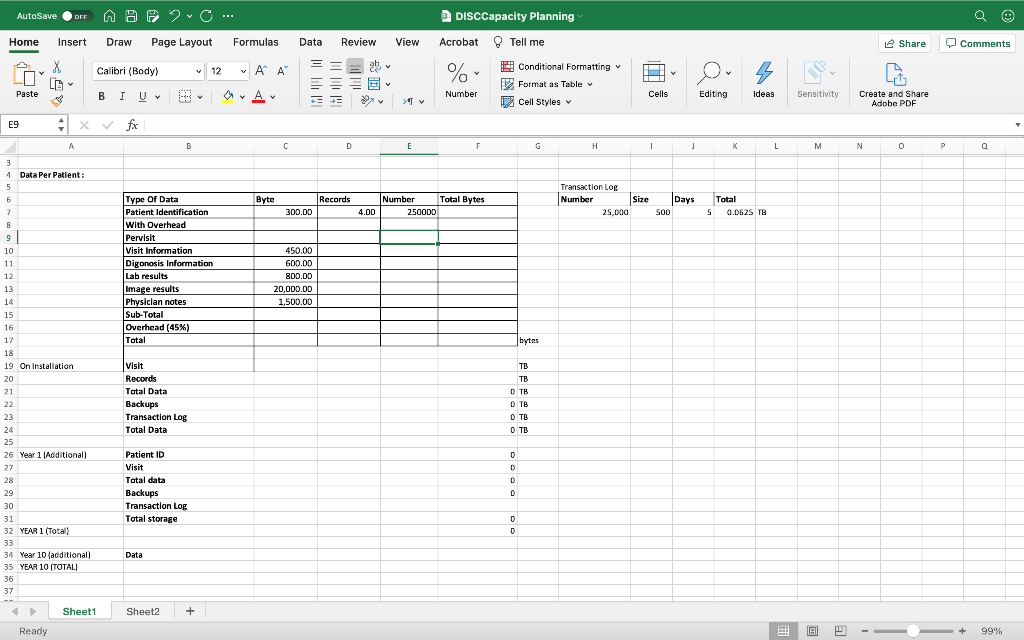

AutoSave OFF AAC2... Q Home Insert Draw Page Layout Formulas Data Review View e Share Comments = DISCCapacity Planning Acrobat Tell me % Conditional Formatting TV Format as Table Number Cell Styles Calibri (Body) 12 AA at 4 V Paste B I U Cells Editing Ideas Sensitivity > Create and Share Adobe PDF E9 fx A B C E F G . H 1 K L M N N 0 3 4 5 Data Per Patient : Byte Records Number Total Bytes 250000 Transaction LOE Number Size 25,000 Days SOD Total 5 0.0625 TB 300.00 4.00 6 7 8 9 10 11 Type Of Data Patient Identification With Overhead Pervisit Visit Information Digonosis Information Lab results Image results Physician notes Sub-Total Overhead (45%) Total 12 450.00 600.00 800.00 20,000.00 1,500.00 13 14 15 16 17 bytes TE Visit Records Total Data Backups Transaction Log Total Data TB DTB DTB D D 18 19 On Installation 20 21 22 23 24 25 26 Year 1 Additional) 27 28 29 30 31 32 YEAR 1 (Total) 33 34 Year 10 (additional) 35 YEAR 10 (TOTALI 36 37 Patient ID Visit Total data Backups Transaction Log Total storage D D Data Sheet1 Sheet2 + Ready IB 99% IT210 Systems Engineering Capacity Planning You are in the DevOps group at the hospital where the organization is implementing a now Electronic Medical Records (EMR) system. You are asked to estimate the amount of and cost of the required storage capacity. The project manager has given you the following information: 1. The hospital currently has 1,250,000 patients in a legacy system which has been running for the past 10 years. These will be transferred to the new system. 2. It is estimated that 250,000 new patients will be added each year and 100,000 existing patients will return for a visit every year. For those patients in the legacy system, the average number of visits over 10 years is 6. 3. The new system includes the following data. 1. Patient identification (300 bytes) 2. Visit information (450 bytes per visit) 3. Diagnosis information (600 bytes per diagnosis), average number of diagnosis is 3 4. Lab results (800 bytes per lab), average number of labs per visit is 3 5. Image results (20,000 bytes per image), average number of images per visit is 2 6. Physician notes (1,500 bytes per contact), average number of contacts per visit is 6 4. Allow 45% overhead for the database management system (including additional files for indexing, metadata, etc.) 5. A full backup will be taken daily and each backup will be kept for 10 days. 6. A daily transaction log will be maintained for 5 days; it is estimated that there are some 25,000 transactions per day (average size is 500 bytes) 7. Develop a detailed spreadsheet showing your calculations on disk capacity requirements: 1. When system installed 2. At 1 year 3. At 10 years Note: the project manager says these numbers may change so make a spreadsheet that allows you to easily change the numbers AutoSave OFF AAC2... Q Home Insert Draw Page Layout Formulas Data Review View e Share Comments = DISCCapacity Planning Acrobat Tell me % Conditional Formatting TV Format as Table Number Cell Styles Calibri (Body) 12 AA at 4 V Paste B I U Cells Editing Ideas Sensitivity > Create and Share Adobe PDF E9 fx A B C E F G . H 1 K L M N N 0 3 4 5 Data Per Patient : Byte Records Number Total Bytes 250000 Transaction LOE Number Size 25,000 Days SOD Total 5 0.0625 TB 300.00 4.00 6 7 8 9 10 11 Type Of Data Patient Identification With Overhead Pervisit Visit Information Digonosis Information Lab results Image results Physician notes Sub-Total Overhead (45%) Total 12 450.00 600.00 800.00 20,000.00 1,500.00 13 14 15 16 17 bytes TE Visit Records Total Data Backups Transaction Log Total Data TB DTB DTB D D 18 19 On Installation 20 21 22 23 24 25 26 Year 1 Additional) 27 28 29 30 31 32 YEAR 1 (Total) 33 34 Year 10 (additional) 35 YEAR 10 (TOTALI 36 37 Patient ID Visit Total data Backups Transaction Log Total storage D D Data Sheet1 Sheet2 + Ready IB 99% IT210 Systems Engineering Capacity Planning You are in the DevOps group at the hospital where the organization is implementing a now Electronic Medical Records (EMR) system. You are asked to estimate the amount of and cost of the required storage capacity. The project manager has given you the following information: 1. The hospital currently has 1,250,000 patients in a legacy system which has been running for the past 10 years. These will be transferred to the new system. 2. It is estimated that 250,000 new patients will be added each year and 100,000 existing patients will return for a visit every year. For those patients in the legacy system, the average number of visits over 10 years is 6. 3. The new system includes the following data. 1. Patient identification (300 bytes) 2. Visit information (450 bytes per visit) 3. Diagnosis information (600 bytes per diagnosis), average number of diagnosis is 3 4. Lab results (800 bytes per lab), average number of labs per visit is 3 5. Image results (20,000 bytes per image), average number of images per visit is 2 6. Physician notes (1,500 bytes per contact), average number of contacts per visit is 6 4. Allow 45% overhead for the database management system (including additional files for indexing, metadata, etc.) 5. A full backup will be taken daily and each backup will be kept for 10 days. 6. A daily transaction log will be maintained for 5 days; it is estimated that there are some 25,000 transactions per day (average size is 500 bytes) 7. Develop a detailed spreadsheet showing your calculations on disk capacity requirements: 1. When system installed 2. At 1 year 3. At 10 years Note: the project manager says these numbers may change so make a spreadsheet that allows you to easily change the numbers








